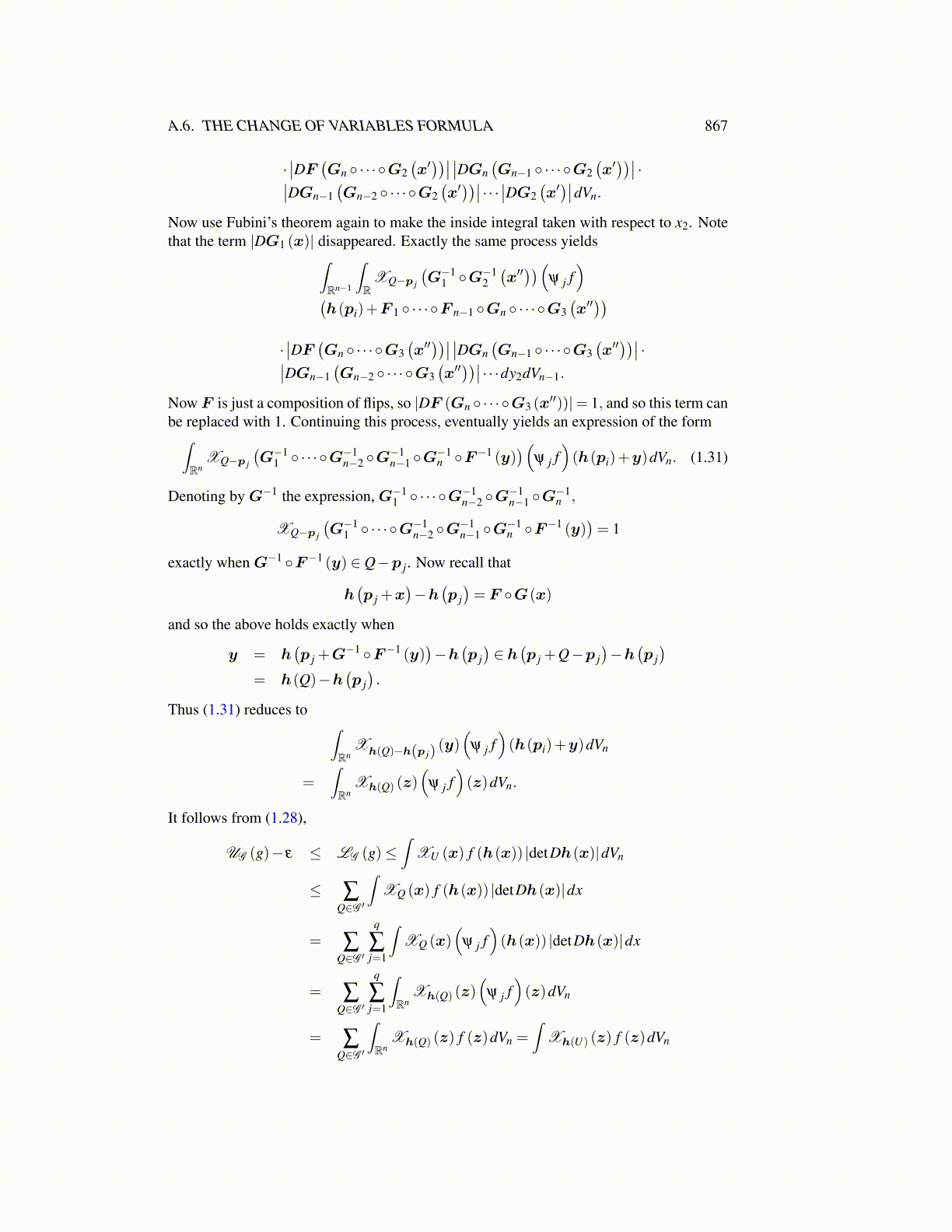
A.6. THE CHANGE OF VARIABLES FORMULA 867
·∣∣DF
(Gn ◦ · · · ◦G2
(x′))∣∣ ∣∣DGn
(Gn−1 ◦ · · · ◦G2
(x′))∣∣ ·∣∣DGn−1
(Gn−2 ◦ · · · ◦G2
(x′))∣∣ · · · ∣∣DG2
(x′)∣∣dVn.
Now use Fubini’s theorem again to make the inside integral taken with respect to x2. Notethat the term |DG1 (x)| disappeared. Exactly the same process yields∫
Rn−1
∫R
XQ−p j
(G−1
1 ◦G−12(x′′))(
ψ j f)
(h(pi)+F 1 ◦ · · · ◦F n−1 ◦Gn ◦ · · · ◦G3
(x′′))
·∣∣DF
(Gn ◦ · · · ◦G3
(x′′))∣∣ ∣∣DGn
(Gn−1 ◦ · · · ◦G3
(x′′))∣∣ ·∣∣DGn−1
(Gn−2 ◦ · · · ◦G3
(x′′))∣∣ · · ·dy2dVn−1.
Now F is just a composition of flips, so |DF (Gn ◦ · · · ◦G3 (x′′))|= 1, and so this term can
be replaced with 1. Continuing this process, eventually yields an expression of the form∫Rn
XQ−p j
(G−1
1 ◦ · · · ◦G−1n−2 ◦G
−1n−1 ◦G
−1n ◦F−1 (y)
)(ψ j f
)(h(pi)+y)dVn. (1.31)
Denoting by G−1 the expression, G−11 ◦ · · · ◦G
−1n−2 ◦G
−1n−1 ◦G
−1n ,
XQ−p j
(G−1
1 ◦ · · · ◦G−1n−2 ◦G
−1n−1 ◦G
−1n ◦F−1 (y)
)= 1
exactly when G−1 ◦F−1 (y) ∈ Q−p j. Now recall that
h(p j +x
)−h
(p j)= F ◦G(x)
and so the above holds exactly when
y = h(p j +G−1 ◦F−1 (y)
)−h
(p j)∈ h
(p j +Q−p j
)−h
(p j)
= h(Q)−h(p j).
Thus (1.31) reduces to ∫Rn
Xh(Q)−h(p j)(y)(
ψ j f)(h(pi)+y)dVn
=∫Rn
Xh(Q) (z)(
ψ j f)(z)dVn.
It follows from (1.28),
UG (g)− ε ≤ LG (g)≤∫
XU (x) f (h(x)) |detDh(x)|dVn
≤ ∑Q∈G ′
∫XQ (x) f (h(x)) |detDh(x)|dx
= ∑Q∈G ′
q
∑j=1
∫XQ (x)
(ψ j f
)(h(x)) |detDh(x)|dx
= ∑Q∈G ′
q
∑j=1
∫Rn
Xh(Q) (z)(
ψ j f)(z)dVn
= ∑Q∈G ′
∫Rn
Xh(Q) (z) f (z)dVn =∫
Xh(U) (z) f (z)dVn